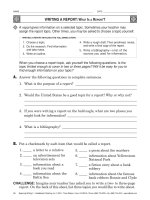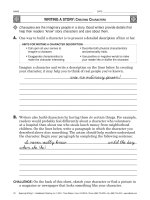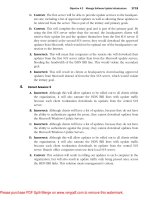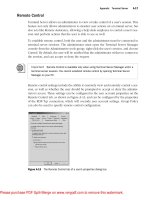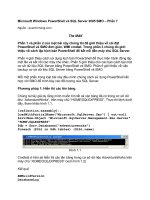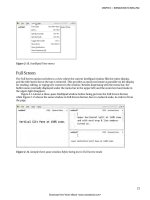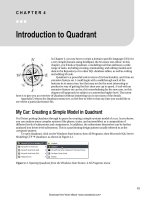Tài liệu Beginning Windows Phone 7 Development pptx
Bạn đang xem bản rút gọn của tài liệu. Xem và tải ngay bản đầy đủ của tài liệu tại đây (18.59 MB, 481 trang )
Start developing applications
for the Windows Phone quickly and easily
Beginning
Windows Phone 7
Development
Henry Lee
|
Eugene Chuvyrov
Start developing applications
for the Windows Phone quickly and easily
Beginning
Windows Phone 7
Development
Henry Lee
|
Eugene Chuvyrov
Start developing applications
for the Windows Phone quickly and easily
Beginning
Windows Phone 7
Development
Henry Lee
|
Eugene Chuvyrov
Start developing applications
for the Windows Phone quickly and easily
Beginning
Windows Phone 7
Development
Henry Lee
|
Eugene Chuvyrov
Start developing applications
for the Windows Phone quickly and easily
Beginning
Windows Phone 7
Development
Henry Lee
|
Eugene Chuvyrov
Start developing applications
for the Windows Phone quickly and easily
Beginning
Windows Phone 7
Development
Henry Lee
|
Eugene Chuvyrov
Start developing applications
for the Windows Phone quickly and easily
Beginning
Windows Phone 7
Development
Henry Lee
|
Eugene Chuvyrov
Start developing applications
for the Windows Phone quickly and easily
Beginning
Windows Phone 7
Development
Henry Lee
|
Eugene Chuvyrov
Download from Wow! eBook <www.wowebook.com>
i
Beginning Windows
Phone 7 Development
■ ■ ■
Henry Lee
and
Eugene Chuvyrov
ii
Beginning Windows Phone 7 Development
Copyright © 2010 by Henry Lee & Eugene Chuvyrov
All rights reserved. No part of this work may be reproduced or transmitted in any form or by any means,
electronic or mechanical, including photocopying, recording, or by any information storage or retrieval system,
without the prior written permission of the copyright owner and the publisher.
ISBN-13 (pbk): 978-1-4302-3216-2
ISBN-13 (electronic): 978-1-4302-3217-9
Printed and bound in the United States of America 9 8 7 6 5 4 3 2 1
Trademarked names, logos, and images may appear in this book. Rather than use a trademark symbol with
every occurrence of a trademarked name, logo, or image we use the names, logos, and images only in an
editorial fashion and to the benefit of the trademark owner, with no intention of infringement of the trademark.
The use in this publication of trade names, trademarks, service marks, and similar terms, even if they are not
identified as such, is not to be taken as an expression of opinion as to whether or not they are subject to
proprietary rights.
President and Publisher: Paul Manning
Lead Editor: Ewan Buckingham
Development Editor: John Osborn
Technical Reviewer: Stefan Turalski
Editorial Board: Steve Anglin, Mark Beckner, Ewan Buckingham, Gary Cornell, Jonathan Gennick,
Jonathan Hassell, Michelle Lowman, Matthew Moodie, Duncan Parkes, Jeffrey Pepper, Frank
Pohlmann, Douglas Pundick, Ben Renow-Clarke, Dominic Shakeshaft, Matt Wade, Tom Welsh
Coordinating Editor: Jennifer L. Blackwell
Copy Editor: Mary Ann Fugate
Compositor: MacPS, LLC
Indexer: Brenda Miller
Artist: April Milne
Cover Designer: Anna Ishchenko
Distributed to the book trade worldwide by Springer Science+Business Media, LLC., 233 Spring Street, 6th
Floor, New York, NY 10013. Phone 1-800-SPRINGER, fax (201) 348-4505, e-mail orders-ny@springer-
sbm.com, or visit www.springeronline.com.
For information on translations, please e-mail , or visit www.apress.com.
Apress and friends of ED books may be purchased in bulk for academic, corporate, or promotional use. eBook
versions and licenses are also available for most titles. For more information, reference our Special Bulk Sales–
eBook Licensing web page at www.apress.com/info/bulksales.
The information in this book is distributed on an “as is” basis, without warranty. Although every precaution has
been taken in the preparation of this work, neither the author(s) nor Apress shall have any liability to any
person or entity with respect to any loss or damage caused or alleged to be caused directly or indirectly by the
information contained in this work.
The source code for this book is available to readers at www.apress.com.
iii
To Erica, my beautiful wife, for her love and support.
Thank you for always being there for me.
—Henry Lee
To Marianna—my friend, my wife, my muse—and to
my parents for their gift of unconditional love.
—Eugene Chuvyrov
iv
Contents at a Glance
■Contents v
■About the Authors xvi
■About the Technical Reviewer xvii
■Acknowledgments xviii
■Introduction xix
Part 1: The Essentials of Windows Phone 7 Application Development 1
■Chapter 1: Introducing Windows Phone 7 and the Windows Phone Platform 3
■Chapter 2: Building Windows Phone 7 Applications 15
■Chapter 3: Using Cloud Services As Data Stores 35
■Chapter 4: Catching and Debugging Errors 97
■Chapter 5: Packaging, Publishing, and Managing Applications 121
Part 2: Using Windows Phone 7 Technologies 139
■Chapter 6: Working with the Accelerometer 141
■Chapter 7: Application Bar 161
■Chapter 8: WebBrowser Control 179
■Chapter 9: Working with Controls and Themes 193
■Chapter 10: Integrating Applications with the Windows Phone OS 211
■Chapter 11: Creating Trial Applications 229
■Chapter 12: Internationalization 251
■Chapter 13: Isolated Storage 267
■Chapter 14: Using Location Services 285
■Chapter 15: Media 311
■Chapter 16: Working with the Camera and Photos 329
■Chapter 17: Push Notifications 347
■Chapter 18: Reactive Extensions for .NET 383
■Chapter 19: Security 413
■Index 441
v
Contents
■Contents at a Glance iv
■About the Authors xvi
■About the Technical Reviewer xvii
■Acknowledgments xviii
■Introduction xix
Part 1: The Essentials of Windows Phone 7 Application Development 1
■Chapter 1: Introducing Windows Phone 7 and the
Windows Phone Platform 3
Windows Phone Overview 5
Windows Phone Hardware Specifications 5
Windows Phone Application Platform 7
Silverlight for Windows Phone 7
XNA for Windows Phone 8
Tools 8
Cloud Services 11
Metro Design 12
Application Development Life Cycle 12
Summary 14
■Chapter 2: Building Windows Phone 7 Applications 15
Preparing Your Development Machine 15
Building Your First Windows Phone 7 Application 15
Creating a Windows Phone Project 16
■ CONTENTS
vi
Using Your First Windows Phone Silverlight Controls 18
Writing Your First Windows Phone Code 22
Running Your First Silverlight Windows Phone Application 23
Customizing Your First Windows Phone Application 25
Styling Your Application 28
Summary 34
■Chapter 3: Using Cloud Services As Data Stores 35
Introducing the MVVM Pattern 36
Introducing Microsoft Azure and SQL Azure 37
Creating a Cloud Database 37
Creating an SQL Azure Database 38
Creating a Database in SQL Azure 47
Creating a Cloud Service to Access the Cloud Database 50
Creating a Windows Azure Project 51
Generating an Object Model to Access the Cloud Database 52
Implementing a WCF Service to Access the SQL Azure Database 57
Building a Phone Client to Access a Cloud Service 64
Creating a Windows Phone Project 64
Building the User Interface 65
Coding MainPage 71
Coding the BoolToVisibilityConvert 72
Adding Reference to NotepadService 74
Coding NotepadViewModel 75
Testing the Application Against NotepadService Deployed Locally 82
Deploying the Service to Windows Azure 83
Testing the Notepad Application Against NotepadService Azure Service 94
Summary 95
■Chapter 4: Catching and Debugging Errors 97
Debugging Application Exceptions 97
Debugging Page Load Exceptions 98
■ CONTENTS
vii
Debugging a Web Service Exception 102
Testing the Application 107
Registering a Windows Phone Device for Debugging 107
Handling Device Exceptions 113
Creating the CatchDeviceExceptionDemo Project 114
Building the User Interface 115
Coding the Application 117
Testing the Finished Application 119
Summary 119
■Chapter 5: Packaging, Publishing, and Managing Applications 121
Windows Phone Application Publishing Lifecycle 121
Windows Phone Application Certification Requirements 123
Application Policies 123
Content Policies 125
Application Submission Validation Requirements 125
Application Certification Requirements 126
Submitting Your First Windows Phone Application to
the Windows Phone Marketplace 128
Package the application 128
Submit the application 129
Updating your application 136
Finding your application in the Marketplace 137
Summary 138
Part 2: Using Windows Phone 7 Technologies 139
■Chapter 6: Working with the Accelerometer 141
Understanding Orientation and Movement 141
Calculating Distance 144
Calculating Pitch and Roll 144
Introducing SDK Support for Accelerometers 146
■ CONTENTS
viii
Retrieving Accelerometer Data 146
Creating the CaptureAccelerometerData Project 147
Building the User Interface 148
Coding the Application 150
Testing the Finished Application 152
Using Accelerometer Data to Move a Ball 153
Creating the MoveBall Project 154
Building the User Interface 155
Coding the Application 157
Testing the Finished Application 159
Summary 159
■Chapter 7: Application Bar 161
Introducing the Application Bar 162
Adding an Application Bar to a Windows Phone 7 Application 163
Adding Images for Use with Application Bar Buttons 164
Adding a Global Application Bar Using XAML 166
Adding a Local Application Bar Using XAML 167
Adding Menu Items 168
Adding an Application Bar Using Managed Code 169
Wiring Up Events to an Application Bar 171
Adding “Glue” Code and a “Worker Function” to the Add Button 171
Reacting to Add Button Events 172
Reacting to Save Button Events 175
Reacting to Menu Events 175
Adding Event Handlers with XAML 176
Summary 177
■Chapter 8: WebBrowser Control 179
Introducing the WebBrowser Control 179
Adding a WebBrowser Control 180
■ CONTENTS
ix
Using a WebBrowser Control to Display Web Content 181
Using a WebBrowser Control to Display Local HTML Content 183
Using a WebBrowser Control to Display Dynamic Content 185
Saving Web Pages Locally 187
Choosing Display and Security Settings 188
Viewport 188
CSS 189
Security 190
Summary 191
■Chapter 9: Working with Controls and Themes 193
Introducing the Metro Design System 193
Windows Phone Chrome 194
Screen Orientations 195
Themes on Windows Phone 7 Devices 196
Applying a Theme 196
Changing the Theme 198
Detecting the Currently Selected Theme 200
Panorama and Pivot Controls 201
Using the Panorama Control 201
Using the Pivot Control 205
Understanding Frame and Page Navigation 205
Creating a User Interface for NavigationTest Project 206
Adding Navigation Code 206
Adding Code to Pass Parameters Between Pages 207
Adding Transition Effects 207
Creating a User Interface 207
Downloading TiltEffect.cs and Applying Dependency Properties 209
Summary 210
■ CONTENTS
x
■Chapter 10: Integrating Applications with the Windows Phone OS 211
Introducing Windows Phone 7 Launchers and Choosers. 211
Launchers . 212
Choosers . 213
Working with Launchers and Choosers . 213
Creating the User Interface. 213
Coding Application Logic. 214
Working with the Windows Phone 7 Application Life Cycle. 215
Observing Application Life Cycle Events. 216
Managing Application State. 220
Best Practices for Managing the Application Life Cycle on the Windows Phone 7 OS 225
Windows Phone 7 Hubs . 225
Summary. 227
■Chapter 11: Creating Trial Applications 229
Understanding Trial and Full Modes 229
Using the IsTrial Method . 230
Using the Marketplace APIs . 231
Simulating Application Trial and Full Modes. 234
Building a Trial Application . 237
Building the User Interface . 238
Connecting to a Web Service . 242
Adding Page-to-Page Navigation. 244
Verifying Trial and Full Mode . 246
Adding Finishing Touches. 247
Summary. 249
■Chapter 12: Internationalization 251
Understanding Internationalization 251
Using Culture Settings with ToString to Display Dates, Times, and Text. 252
Using the .NET Culture Hierarchy to Ensure Culture Neutrality. 254
Download from Wow! eBook <www.wowebook.com>
■ CONTENTS
xi
Storing and Retrieving Current Culture Settings 256
Using Resource Files to Localize Content 260
Summary 265
■Chapter 13: Isolated Storage 267
Working with Isolated Directory Storage 268
Creating the IsolatedStorageStoreImageDemo Project 269
Coding the User Interface 270
Coding the Application 272
Working with Isolated Storage Settings 276
Creating a New Project 277
Building the Application UI (XAML) 278
Coding Application Behavior (C#) 281
Summary 283
■Chapter 14: Using Location Services 285
Understanding Windows Phone Location Services Architecture 285
Introducing the Windows Phone Location Service and Mapping APIs 286
Simulating the Location Service 286
Creating the GeoCoordinateWatcherDemo Project 287
Coding the User Interface 288
Coding the Application 290
Testing the Finished Application 292
Using GeoCoordinateWatcher and the Bing Maps Control to Track Your Movements 292
Registering with the Bing Maps Service Portal and Installing the Bing Maps SDK 293
Creating the BingMapDemo Project 295
Coding the User Interface 297
Coding the Application 299
Testing the Finished Application 302
Plotting an Address on a Bing Maps Map and Working with the Bing Maps Service . 303
Creating the AddressPlottingDemo Application 304
■ CONTENTS
xii
Adding a Service Reference to the Bing Maps GeoCodeService 304
Coding the User Interface 306
Coding the Application 308
Testing the Finished Application 310
Summary 310
■Chapter 15: Media 311
Introducing MediaElement 311
Working with Video 312
Creating the MediaPlayerDemo Project 313
Building the User Interface 314
Coding the Application 317
Adding Sounds to an Application 322
Creating the RobotSoundDemo Project 323
Building the User Interface 324
Coding the Application 327
Summary 328
■Chapter 16: Working with the Camera and Photos 329
Introducing Windows Phone 7 Photo Features 329
Using a Chooser to Take Photos 331
Using a Chooser to Open Photos 334
Saving Photos to the Phone 336
Integrating Your Application with Windows Phone 7 338
Using Extras to Launch an Application 338
Using Share to Upload PhotoCapture Snapshots to TwitPic 340
Summary 347
■Chapter 17: Push Notifications 347
Understanding Push Notifications 347
Toast Notifications 347
Tile Notifications 348
■ CONTENTS
xiii
Raw Notifications 349
Introducing the Push Notifications Architecture 349
The Life Cycle of a Notification 350
The Push Notification Framework 352
Implementing Toast Notifications 353
Creating a Client Application 353
Creating an Application to Send Notifications 358
Implementing Tile Notifications 363
Creating a Client Application 364
Creating an Application to Send Notifications 364
Implementing Raw Notifications 367
Creating a Client Application 368
Creating an Application to Send Notifications 371
Testing Delivery of Raw Notifications 372
Implementing Cloud Service to Track Push Notifications 372
Creating a WCF Service to Track Notification Recipients 373
Modifying the Client to Call the WCF Service 378
Verifying Automated Push Notification Subscriber Tracking 380
Using Push Notifications in the Real World 381
Summary 381
■Chapter 18: Reactive Extensions for .NET 383
Introducing Reactive Programming 384
Implementing the Observer Pattern with Rx.NET 386
Creating a Windows Phone Project 386
Adding Code to Create and Read Observable Collections 386
Using Rx.NET Event Handling to Search for Flickr Photographs 388
Creating a Windows Phone Project 389
Adding a User Interface 390
Adding Logic to Search Flickr for Images 390
■ CONTENTS
xiv
Enhancing a Flickr Search with Throttling 391
Adding an Animation that Plays as Flickr Images Load 393
Using Rx.NET with Web Services to Asynchronously Retrieve Weather Data 398
Creating a Windows Phone Project 398
Creating a User Interface 399
Adding Logic to Get Weather Information 401
Handling Errors in Rx.NET 403
Handling Data Connection Issues with Rx.NET 404
Revising WeatherRx to Manage Slow Data Connections 405
Handling Multiple Concurrent Requests with Rx.NET 408
Summary 410
■Chapter 19: Security 413
Understanding Application Security 413
Windows Phone Marketplace 413
Submitting an Application to Windows Phone Marketplace 415
Sandboxed Execution and the Execution Manager 417
Implementing Network Security 417
Securing Connections with SSL 418
Testing and Opening an SSL Connection 418
Creating a Self-Signed Certificate 419
Exporting a Self-Signed Certificate 423
Installing Self-Signed Certificate on Windows Phone 7 425
Implementing Data Security 426
Using HMACSHA1 and HMACHSHA256 428
Using Rfc2898DeriveBytes and AES to Encrypt Data 431
Understanding Device Physical Security 435
Map It 435
Ring It 435
Lock It and Display a Message 436
■ CONTENTS
xv
Erase It 436
Capability List 436
Meeting Certification Requirements 436
Application Must Implement MSIL Code 436
Application Must Not Implement Any Security-Critical Code 438
Summary 439
■Index 441
■ CONTENTS
xvi
About the Authors
■ Henry Lee is the founder of NewAgeSolution.net and is passionate about
technology. He works with various Fortune 500 companies, delivering mobile
applications and rich Internet applications. He recently formed a startup company
called ToeTapz.com, focusing his energy on delivering mobile applications in
Windows Phone 7, Android, and iPhone. In his spare time, he dedicates his effort to
help his .NET community by delivering sessions at technology events. He enjoys
talking with other technologists about current trends in technology and sharing
business insights with fellow colleagues. Often you will find Henry at a local cigar bar,
enjoying a cigar and a drink, trying to come up with the next big mobile application.
■ Eugene Chuvyrov is an independent .NET consultant in beautiful Jacksonville,
Florida. He was lucky enough to start working with Microsoft technologies when he
graduated from college in 1998, and has been consistently delivering a positive return
on investment to the clients that engage him. His most recent venture is an online
event marketing startup, packedhouseevents.com, which extends event creation,
marketing, and electronic payments to anybody with Internet access. Eugene also
facilitates the meetings of the Jacksonville Software Architecture Group, where he
enjoys networking and learning from smart people.
As soon as Eugene heard the news that a new mobile platform (Windows Phone
7) was being released by Microsoft, he was immediately intrigued. It was hard to resist
the temptation of wide-open possibilities to create smartphone applications using his favorite IDE and
all the latest cloud and functional programming–based technologies. This passion, combined with a
cigar with Henry at a local cigar bar, resulted in the book you now hold in your hands. He sincerely
hopes you find it useful!
xvii
About the Technical Reviewer
■ Stefan Turalski is a nice chap who is capable of performing both magic and trivial
things, with a little help from code, libraries, tools, APIs, servers, and the like. Wearing
many hats, he has experienced almost all aspects of the software life cycle, and is
especially skilled in business analysis, design, implementation, testing, and QA. His
main area of interest is quite wide and could be summarized as emerging
technologies, with a recent focus on .NET 4, mobile development, functional
programming, and software engineering at large.
Before he realized that he enjoys criticizing other people’s work more, Stefan
published several technical articles, mainly about .NET technology, SOA, and software
engineering. For the last ten or so years, he has built solutions ranging from Perl
scripts, through embedded systems and web sites, to highly scalable C++/Java/.NET enterprise-class
systems. Feel free to contact him at
■ INTRODUCTION
xviii
Acknowledgments
We would like to express our love and gratitude to our wives for letting us ignore dog walking,
dishwashing, and housecleaning chores to write this book—but most of all for providing love and
support during the rough times, which encouraged us to finish this book. We would also like to thank Joe
Healy for providing technical support and giving us access to the Windows Phone 7 prototype phone,
which helped tremendously in writing this book.
We are also grateful to Apress for giving us the opportunity to write about what we love to do and
share it with the world. The staff at Apress made this book possible by spending many days and nights
reviewing and editing the book to meet the tight deadline. Ewan Buckingham provided us with this
unique opportunity to share our knowledge. Thank you, Ewan, for believing in us. Stefan Turalski has
given us consistent in-depth technical guidance and commentary—thank you for ensuring that we use
industry best practices at all times. John Osborn made our book understandable not only to the two of
us, but to the rest of the world as well. Thank you, John; we are much better writers now because of you!
Mary Ann Fugate performed very timely copyedit checks and ensured that all the references and
grammar made sense—thank you, Mary Ann.
However, this book would have never come to fruition if it weren’t for our coordinating editor,
Jennifer Blackwell. Jennifer encouraged us when we needed encouragement, provided guidance when
we were lost, and made us see the light at the end of the tunnel at all times. For that, we are extremely
grateful!
xix
Introduction
We decided that we should write a book about something we enjoy doing to share with our fellow
developers to fulfill their dreams. This is how our journey started. When the startup company
NewAgeSolution.net was founded, the company emphasized delivering compelling rich Internet
applications using Silverlight. The company enjoyed great success, with eight employees, delivering
amazing Silverlight applications that you can read about in a Microsoft case study
(www.microsoft.com/casestudies/Case_Study_Detail.aspx?CaseStudyID=4000006798).
Then Microsoft invited many of the Silverlight partners to join the Windows Phone Partner
program, and after attending the Windows Phone partner conference in Redmond at the Microsoft
campus, we truly believed that the age of the smartphone had begun. It was a natural progression for us
to tackle Windows Phone, since Silverlight is one of the primary development platforms, and we were
able to utilize all the knowledge that we had gained over the years.
Windows Phone is our passion and our daily life, The Windows Phone market is big, and we want to
share our dream with you by showing you how to successfully develop a Windows Phone application so
you can also deploy your dream to the Marketplace.
Who This Book Is For
This book assumes that you have basic C# and .NET knowledge. This book will provide you with basic
fundamentals and skills that you will need to be successful in developing a Windows Phone application.
You do not need previous experience in developing a mobile application—the only thing you need is a
desire to learn new technology.
What You Need to Use This Book
In order to write Windows Phone applications and to test out the examples in this book, you’ll need to
download the tools listed here. All of these are available at no charge from Microsoft. You’ll find
additional information on how to install and use these tools in Part 1 of this book.
• Windows Phone Developer Tools RTW
( />00B7CED31729/vm_web.exe)
• Zune Software (www.zune.net/en-us/products/software/download/)
• Windows Phone 7 UI Design and Interface Guide
(
• Windows Phone 7 Marketplace Certification Requirements
(
• Microsoft SQL 2008 R2 Express (www.microsoft.com/express/Database/)
■ INTRODUCTION
xx
• Azure Tools for Visual Studio 1.2 June 2010
( />88C2EC14929E/VSCLOUDSERVICE.EXE)
• Azure SDK June 2010
(www.microsoft.com/downloads/en/details.aspx?FamilyID=21910585-8693-4185-
826e-e658535940aa&displaylang=en)
• Windows Azure Platform Training Kit September—for the latest update, please
check at www.microsoft.com/windowsazure/windowsazure.
(www.microsoft.com/downloads/en/details.aspx?FamilyID=413E88F8-5966-4A83-
B309-53B7B77EDF78&displaylang=en)
How This Book Is Organized
The book contains nineteen chapters broken into two major parts. In Part 1, we will walk you through
the development life cycle of the application. You will go from coding the simplest possible “Hello
World”–style Windows Phone 7 application to building a full-blown, modern n-tier application that uses
both the Windows Phone development platform and the unique cloud services that support it. The
section concludes with step-by-step instruction on how to gain certification from Microsoft and offer an
application to the public through the Windows Phone Marketplace.
In Part 2, you will learn how to use specific features of Windows Phone devices in your applications,
including the accelerometer, location service, application bar, reactive extensions, application hub
integration, application life cycle events, isolated storage, Silverlight, XAML, skinning controls, web
browser controls, media elements, photos, push notifications, internalization, and security. While each
of its chapters is a tutorial, you can also use Part 2 as a reference. Each chapter will focus on a single
phone feature and provide step-by-step instructions on how to incorporate it into your application.
Where to Find Sources for the Examples
The source code of all of the examples is available at www.apress.com/book/view/1430232161.
Send Us Your Comments
We value your input. We’d like to know what you like about the book and what you don’t like about it.
You can send us comments via e-mail to When providing feedback, please make
sure you include the title of the book in your note to us.
We’ve tried to make this book as error-free as possible. However, mistakes happen. If you find any
type of error in this book, whether it is a typo or an erroneous command, please let us know about it.
Please e-mail the problem to Your information will be validated and posted on the
errata page to be used in subsequent editions of the book. The corrigenda can be viewed on the book’s
web page at .
Contacting the Authors
You can contact us directly at the following e-mail addresses:
Henry Lee:
Eugene Chuvyrov:
Download from Wow! eBook <www.wowebook.com>
P A R T 1
■ ■ ■
The Essentials of
Windows Phone 7
Application Development
In Part 1, you will be introduced to the full development life cycle of a Windows
Phone 7 application: installing and understanding the tools and SDKs; deploying
database and service layers to the Azure cloud; creating a connected Windows Phone
application; debugging and catching errors; and finally deploying your application to
the Marketplace. These skills are essential for developing a successful application. In
Part 1, the focus is on building the application, getting familiar with development
tools like Visual Studio for Windows Phone and Microsoft Expression Blend for
Windows Phone, and learning to interact with the Windows Phone developer portal,
rather than special phone features such as the GPS radio or accelerometer. We’ll turn
to those in Part 2.
2
C H A P T E R 1
■ ■ ■
3
Introducing Windows Phone 7 and
the Windows Phone Platform
This is an exciting time for developers, as the smartphone race has begun between the major players,
like Microsoft’s Windows Phone, Apple’s iPhone, and Google’s Android. As a developer, you are faced
with this amazing opportunity to develop a mobile application that can be sold to millions of consumers
worldwide using any of the platforms (Windows Phone, iPhone, and Android). By 2014 the Gartner
report predicts that the smartphone market will boom and there will be billions of dollars at stake. This
could well be the next big “dot com boom” that everyone’s been waiting for.
The Marketplace for Windows Phone, where consumers can purchase applications, is virtually
untapped as the market will open to the public on November of 2010, and you will have a chance to
publish an application that is first to the market. You might consider downloading Zune software from
www.zune.net/en-US/products/software/download/downloadsoftware.htm to view the current
Marketplace. Once you have downloaded the Zune software and fired it up, click marketplace ➤ APPS
links, and you will be able to see all the Windows Phone applications currently published, as shown in
Figure 1–1. You will learn more about the Marketplace in Chapter 5.
Figure 1–1. Windows Phone Marketplace
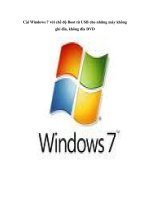
![Tài liệu Microsoft Windows Vista Tutorials [VTC] pptx](https://media.store123doc.com/images/document/13/ce/pe/medium_pew1387001705.jpg)
